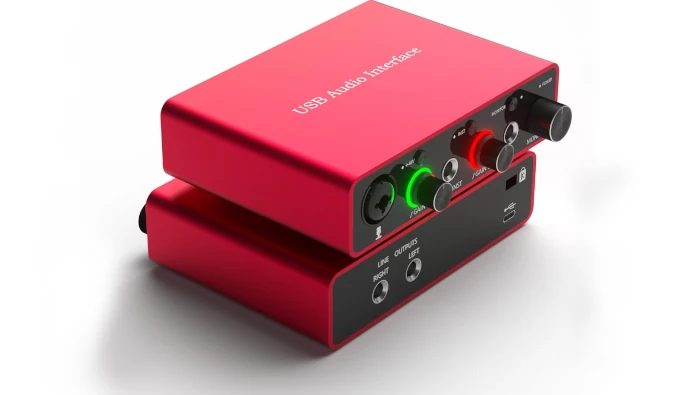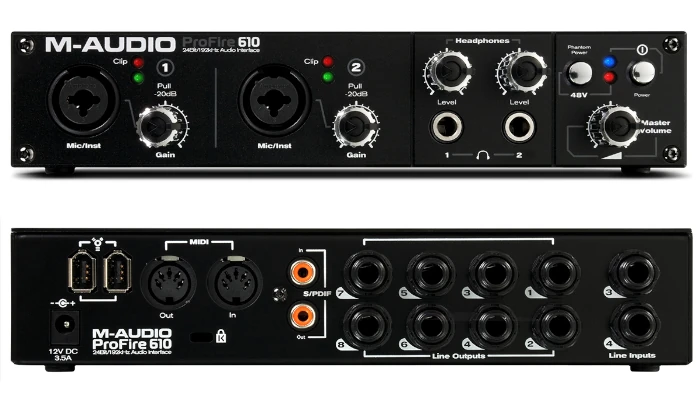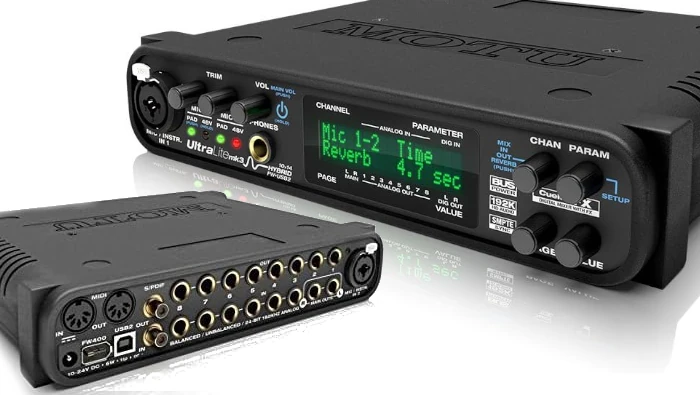HSS Podcast - Plug In and Power Up: USB vs. FireWire in the Home Studio Showdown
HSS Staff
Audio interfaces are essential for any musician or audio engineer looking to record high-quality sound. These devices act as the bridge between your instruments or microphones and your computer, converting analog signals into digital ones. Without an audio interface, capturing the nuances and details of your music would be challenging, if not impossible.
In this blog post, we will explore the differences between USB and FireWire audio interfaces, two of the most common types available. By understanding their unique features, advantages, and potential drawbacks, you can make an informed decision about which interface suits your needs best.
Whether you’re setting up your first home studio or upgrading an existing one, choosing the right audio interface is crucial. For beginners, USB interfaces often provide a more straightforward and cost-effective solution. FireWire interfaces, on the other hand, are known for their high data transfer rates and reliability, making them a favorite among professional users.
To help you navigate this decision, we will break down the key aspects of each type of interface, from speed and performance to compatibility and practical considerations.
By the end of this post, you’ll have a clear understanding of the pros and cons of USB and FireWire audio interfaces, empowering you to choose the best option for your recording needs. Let’s dive in and discover which interface will elevate your music production to the next level.
What is USB?

Universal Serial Bus (USB) is one of the most widely used interfaces for connecting various peripherals to computers, including audio interfaces. USB technology has been around since the mid-1990s, continually evolving to offer improved speed and power capabilities. The most common versions are USB 2.0, USB 3.0, and the latest USB-C, each providing different levels of performance.
USB 2.0
USB 2.0, released in 2000, offers a data transfer rate of up to 480 Mbps. It quickly became the standard for many devices due to its sufficient speed and widespread compatibility. Many budget-friendly audio interfaces still use USB 2.0, making it a reliable choice for home studios and entry-level setups.
USB 3.0 and USB-C
Introduced in 2008, USB 3.0 significantly increased the data transfer rate to 5 Gbps, making it suitable for more demanding applications, such as high-resolution audio recording and streaming. USB-C, the latest version, features a reversible connector and can achieve speeds up to 10 Gbps. It also supports higher power delivery, allowing for more robust and versatile audio interfaces.
Benefits of USB Audio Interfaces
One of the main advantages of USB audio interfaces is their plug-and-play functionality. Most operating systems recognize USB devices automatically, simplifying the setup process. USB interfaces draw power directly from the computer, eliminating the need for external power supplies and enhancing portability.
Additionally, USB ports are ubiquitous on modern computers, ensuring broad compatibility and ease of use. Whether you’re using a desktop, laptop, or even a tablet, chances are you’ll have multiple USB ports available for connecting your audio interface and other peripherals.
For those looking to record on a budget, USB interfaces offer an affordable solution without compromising on quality.
Overall, USB audio interfaces provide a versatile, user-friendly option suitable for beginners and professionals alike. Their widespread compatibility and continuous advancements in speed and power make USB a reliable choice for various recording needs.
What is FireWire?

FireWire, also known as IEEE 1394, is an interface developed by Apple in the late 1980s and early 1990s. Known for its high data transfer rates and robust performance, FireWire became popular in the professional audio and video production industries. Although its usage has declined with the advent of faster USB versions, FireWire remains a reliable choice for specific high-performance applications.
FireWire 400 and 800
FireWire comes in two main versions: FireWire 400 (IEEE 1394a) and FireWire 800 (IEEE 1394b). FireWire 400, introduced in 1995, supports data transfer rates of up to 400 Mbps. FireWire 800, released in 2002, doubles this speed to 800 Mbps, providing faster and more efficient data transfer for demanding tasks.
Benefits of FireWire Audio Interfaces
One of the key advantages of FireWire audio interfaces is their ability to handle continuous, high-speed data streams without interruption. This makes FireWire particularly suitable for professional audio recording and mixing, where maintaining a stable and consistent data flow is crucial.
FireWire interfaces also support daisy-chaining, allowing multiple devices to be connected in a series to a single FireWire port. This feature is particularly beneficial for complex studio setups that require multiple audio devices working simultaneously. Unlike USB, which can suffer from latency issues when multiple devices are connected, FireWire maintains consistent performance across all connected devices.
FireWire vs. USB: Compatibility and Usage
While FireWire offers impressive performance, it is less common in modern computers compared to USB. Many newer laptops and desktops no longer include FireWire ports, making USB a more versatile and widely compatible option. However, for users with existing FireWire-equipped devices or those requiring the specific benefits of FireWire, adapters and expansion cards are available to add FireWire ports to modern systems.
For those looking to enhance their home studio setups, understanding the practical applications of FireWire can be crucial.
FireWire remains a powerful tool for professional audio production, offering high-speed data transfer and stable performance. While its prevalence has decreased in favor of USB, FireWire’s unique advantages make it a valuable option for certain high-end recording setups. If your studio demands robust and consistent performance, FireWire audio interfaces might be the right choice for you.
Speed and Performance Comparison

When choosing between USB and FireWire audio interfaces, speed and performance are critical factors to consider. Both interfaces offer unique advantages, but understanding their differences in data transfer rates and overall performance can help you make an informed decision.
USB Speed and Performance
USB technology has evolved significantly over the years. The most common versions relevant to audio interfaces are USB 2.0, USB 3.0, and USB-C.
- USB 2.0: Offers data transfer rates up to 480 Mbps. It’s widely used and compatible with most computers and audio devices. However, for high-resolution audio recording and multiple input/output channels, its speed might be limiting.
- USB 3.0: Provides a substantial upgrade with speeds up to 5 Gbps, making it suitable for more demanding audio tasks, such as multi-track recording and high-definition audio streaming. Its backward compatibility with USB 2.0 ensures versatility.
- USB-C: The latest iteration, capable of speeds up to 10 Gbps. USB-C’s higher power delivery and faster data rates make it ideal for professional audio interfaces, ensuring low latency and high reliability.
FireWire Speed and Performance
FireWire, known for its consistent and high-speed data transfer, comes in two primary versions: FireWire 400 and FireWire 800.
- FireWire 400: Supports data transfer rates up to 400 Mbps. Although slower than USB 3.0 and USB-C, FireWire 400 offers stable performance for audio recording, minimizing latency issues.
- FireWire 800: Doubles the speed to 800 Mbps, providing a more robust solution for high-end audio production. FireWire 800’s consistent data transfer rates make it ideal for recording multiple tracks simultaneously without glitches or delays.
Practical Performance Considerations
In practical terms, the differences in speed between USB and FireWire may not be noticeable for most home studio setups. USB 2.0 is sufficient for basic recording tasks, while USB 3.0 and USB-C handle more demanding applications with ease. FireWire, despite its lower maximum speeds compared to USB 3.0 and USB-C, excels in maintaining stable and uninterrupted data flow, which can be crucial for professional audio production.
For users seeking consistent and high-performance recording, FireWire offers an advantage in environments requiring reliable data transfer. However, USB interfaces provide greater versatility and compatibility with modern computers. If you’re interested in achieving high-quality recordings, check out our tips on recording high-quality audio on a laptop.
Both USB and FireWire offer valuable features for audio interfaces. USB’s evolving technology and widespread compatibility make it a versatile choice for most users. FireWire’s stable and consistent performance is ideal for professional settings requiring uninterrupted data flow. Assess your specific needs to determine which interface best suits your audio production requirements.
Compatibility and Availability
When selecting an audio interface, compatibility and availability are crucial factors to consider. The differences between USB and FireWire in these areas can significantly impact your choice.
USB Compatibility and Availability
USB interfaces are ubiquitous in the modern tech landscape. Almost every computer, from desktops to laptops and even tablets, comes equipped with multiple USB ports. This widespread compatibility makes USB audio interfaces highly accessible and easy to integrate into various setups.
- Broad Compatibility: USB interfaces work seamlessly with both Windows and macOS systems. Additionally, many USB interfaces are class-compliant, meaning they don’t require additional drivers, simplifying the setup process.
- Availability: Given their popularity, USB audio interfaces are widely available from various manufacturers. You can find USB interfaces at different price points, making them suitable for both beginners and professionals. Whether you need a simple interface for basic recording or a more advanced model for complex projects, there is a USB option available.
For practical home studio advice and to avoid common setup mistakes, check out our guide on common errors in home studios.
FireWire Compatibility and Availability
FireWire interfaces, while known for their performance, are less common in the current market. FireWire ports are becoming rare on modern computers, making compatibility a potential issue.
- Limited Compatibility: FireWire ports are seldom included in new laptops and desktops. Users with older computers might still have FireWire ports, but those with newer models will likely need an adapter or expansion card to connect FireWire devices. This can add to the overall cost and complexity of your setup.
- Niche Availability: FireWire audio interfaces are generally targeted at professionals who require their specific benefits. Consequently, the range of available FireWire interfaces is narrower compared to USB. However, for those who need the consistent data transfer rates that FireWire provides, these interfaces remain a viable option.
For users looking to adapt their current setups, exploring the right tools and techniques can make a significant difference. To tackle audio noise issues, read our guide on removing audio noises.
Practical Considerations
When deciding between USB and FireWire, consider the long-term viability of each interface. USB’s continued evolution and prevalence in modern devices ensure it will remain a standard for years to come. FireWire, while offering specific advantages, is less future-proof due to its declining presence in new hardware.
For most users, USB audio interfaces offer unmatched compatibility and availability, making them the more versatile choice. FireWire interfaces, although limited in compatibility, provide stable performance for professional applications. Assess your current hardware and future needs to determine which interface aligns best with your recording setup.
Conclusion: Which One to Choose?

Choosing between USB and FireWire audio interfaces depends on your specific needs, preferences, and setup. Both interfaces have unique advantages and considerations that can influence your decision.
USB Audio Interfaces
USB audio interfaces are widely regarded for their versatility and ease of use. They offer several key benefits:
- Widespread Compatibility: USB ports are standard on almost all modern computers, ensuring broad compatibility across different devices and operating systems.
- Ease of Use: With plug-and-play functionality, setting up a USB audio interface is straightforward, making it accessible for beginners and professionals alike.
- Affordability: USB interfaces come in a range of price points, catering to various budgets without compromising on quality.
- Future-Proof: The ongoing development of USB technology, including USB 3.0 and USB-C, ensures that USB interfaces remain relevant and capable of handling high-performance tasks.
For most users, especially those starting out or with standard recording needs, USB audio interfaces provide a balanced solution. They are user-friendly, widely supported, and capable of delivering excellent audio quality. For more insights on cost-effective recording setups, explore how to buy home studio equipment spending less.
FireWire Audio Interfaces
FireWire audio interfaces, while less common, are prized in professional circles for their consistent performance and specific features:
- Stable Data Transfer: FireWire offers reliable and uninterrupted data flow, which is crucial for high-end audio production.
- Daisy-Chaining Capability: The ability to connect multiple devices in a series is beneficial for complex studio setups, allowing for seamless integration of various audio equipment.
- Professional Grade: FireWire interfaces are often designed with professional users in mind, offering features and performance suited for demanding audio tasks.
However, the declining availability of FireWire ports on new computers and the need for adapters can be a drawback. For users with existing FireWire-compatible hardware or those requiring its unique benefits, FireWire remains a strong choice. To further enhance your recording quality, consider our tips on improving audio quality in your home studio.
Making the Decision
Ultimately, the decision between USB and FireWire should be based on your current setup, future plans, and specific recording needs:
- For General Use: If you seek a versatile, easy-to-use, and widely compatible solution, USB audio interfaces are the way to go.
- For Professional Use: If your work demands consistent data transfer and the ability to daisy-chain multiple devices, and you have or can acquire the necessary ports, FireWire might be the better option.
Evaluate your requirements, budget, and equipment compatibility to choose the interface that best meets your needs. Both USB and FireWire have their merits, and selecting the right one will ensure you achieve the best possible results in your audio production endeavors.

